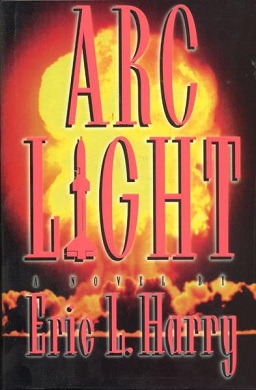
Nuclear warfare, also known as atomic warfare, is a theoretical military conflict or prepared political strategy that deploys nuclear weaponry. Nuclear weapons are weapons of mass destruction; in contrast to conventional warfare, nuclear warfare can produce destruction in a much shorter time and can have a long-lasting radiological result. A major nuclear exchange would likely have long-term effects, primarily from the fallout released, and could also lead to secondary effects, such as "nuclear winter", nuclear famine and societal collapse. A global thermonuclear war with Cold War-era stockpiles, or even with the current smaller stockpiles, may lead to various scenarios including the extinction of the human race.

In nuclear strategy, a first strike or preemptive strike is a preemptive surprise attack employing overwhelming force. First strike capability is a country's ability to defeat another nuclear power by destroying its arsenal to the point where the attacking country can survive the weakened retaliation while the opposing side is left unable to continue war. The preferred methodology is to attack the opponent's strategic nuclear weapon facilities, command and control sites, and storage depots first. The strategy is called counterforce.
In nuclear strategy, minimal deterrence, also known as minimum deterrence and finite deterrence, is an application of deterrence theory in which a state possesses no more nuclear weapons than is necessary to deter an adversary from attacking. Pure minimal deterrence is a doctrine of no first use, holding that the only mission of nuclear weapons is to deter a nuclear adversary by making the cost of a first strike unacceptably high. To present a credible deterrent, there must be the assurance that any attack would trigger a retaliatory strike. In other words, minimal deterrence requires rejecting a counterforce strategy in favor of pursuing survivable force that can be used in a countervalue second strike.
Mutual assured destruction (MAD) is a doctrine of military strategy and national security policy which posits that a full-scale use of nuclear weapons by an attacker on a nuclear-armed defender with second-strike capabilities would cause the complete annihilation of both the attacker and the defender. It is based on the theory of rational deterrence, which holds that the threat of using strong weapons against the enemy prevents the enemy's use of those same weapons. The strategy is a form of Nash equilibrium in which, once armed, neither side has any incentive to initiate a conflict or to disarm.

Nuclear strategy involves the development of doctrines and strategies for the production and use of nuclear weapons.

In nuclear ethics and deterrence theory, No first use (NFU) refers to a type of pledge or policy wherein a nuclear power formally refrains from the use of nuclear weapons or other weapons of mass destruction (WMDs) in warfare, except for as a second strike in retaliation to an attack by an enemy power using WMDs. Such a pledge would allow for a unique state of affairs in which a given nuclear power can be engaged in a conflict of conventional weaponry while it purposefully foregoes any of the strategic advantages of nuclear weapons, provided the enemy power does not possess or utilize any such weapons of their own. The concept is primarily invoked in reference to nuclear mutually assured destruction but has also been applied to chemical and biological warfare, as is the case of the official WMD policy of India.
Nuclear blackmail is a form of nuclear strategy in which an aggressor uses the threat of use of nuclear weapons to force an adversary to perform some action or make some concessions. It is a type of extortion that is related to brinkmanship.
Nuclear utilization target selection (NUTS) is a hypothesis regarding the use of nuclear weapons often contrasted with mutually assured destruction (MAD). NUTS theory at its most basic level asserts that it is possible for a limited nuclear exchange to occur and that nuclear weapons are simply one more rung on the ladder of escalation pioneered by Herman Kahn. This leads to a number of other conclusions regarding the potential uses of and responses to nuclear weapons.

The Force de frappe, or Force de dissuasion after 1961, is the French nuclear deterrent force. The Force de dissuasion used to be a triad of air-, sea- and land-based nuclear weapons intended for dissuasion, the French term for deterrence. France has deactivated its land-based missiles and today the Force de dissuasion incorporates both an air and sea component.

Deterrence theory refers to the scholarship and practice of how threats or limited force by one party can convince another party to refrain from initiating some other course of action. The topic gained increased prominence as a military strategy during the Cold War with regard to the use of nuclear weapons and is related to but distinct from the concept of mutual assured destruction, according to which a full-scale nuclear attack on a power with second-strike capability would devastate both parties. The central problem of deterrence revolves around how to credibly threaten military action or nuclear punishment on the adversary despite its costs to the deterrer.

The Single Integrated Operational Plan (SIOP) was the United States' general plan for nuclear war from 1961 to 2003. The SIOP gave the President of the United States a range of targeting options, and described launch procedures and target sets against which nuclear weapons would be launched. The plan integrated the capabilities of the nuclear triad of strategic bombers, land-based intercontinental ballistic missiles (ICBM), and sea-based submarine-launched ballistic missiles (SLBM). The SIOP was a highly classified document, and was one of the most secret and sensitive issues in U.S. national security policy.
Decapitation is a military strategy aimed at removing the leadership or command and control of a hostile government or group. The strategy of shattering or defeating an enemy by eliminating its military and political leadership has long been utilized in warfare.

Massive retaliation, also known as a massive response or massive deterrence, is a military doctrine and nuclear strategy in which a state commits itself to retaliate in much greater force in the event of an attack.

Flexible response was a defense strategy implemented by John F. Kennedy in 1961 to address the Kennedy administration's skepticism of Dwight Eisenhower's New Look and its policy of massive retaliation. Flexible response calls for mutual deterrence at strategic, tactical, and conventional levels, giving the United States the capability to respond to aggression across the spectrum of war, not limited only to nuclear arms.

In nuclear strategy, a retaliatory strike or second-strike capability is a country's assured ability to respond to a nuclear attack with powerful nuclear retaliation against the attacker. To have such an ability is considered vital in nuclear deterrence, as otherwise the other side might attempt to try to win a nuclear war in one massive first strike against its opponent's own nuclear forces.
The Nuclear doctrine of Pakistan is a theoretical concept of military strategy that promotes deterrence by guaranteeing an immediate "massive retaliation" to an aggressive attack against the state.

Arc Light is the debut novel by Eric L. Harry and is a techno-thriller about a limited nuclear war published in September 1994 and written in 1991 and 1992.
The following outline is provided as an overview of and topical guide to nuclear technology:
The "Schlesinger Doctrine" is the name, given by the press, to a major re-alignment of United States nuclear strike policy that was announced in January 1974 by the US Secretary of Defense, James Schlesinger. It outlined a broad selection of counterforce options against a wide variety of potential enemy actions, a major change from earlier SIOP policies of the Kennedy and Johnson eras that focused on Mutually Assured Destruction and typically included only one or two "all-out" plans of action that used the entire U.S. nuclear arsenal in a single strike. A key element of the new plans were a variety of limited strikes solely against enemy military targets while ensuring the survivability of the U.S. second-strike capability, which was intended to leave an opening for a negotiated settlement.
In nuclear strategy, a counterforce target is one that has a military value, such as a launch silo for intercontinental ballistic missiles, an airbase at which nuclear-armed bombers are stationed, a homeport for ballistic missile submarines, or a command and control installation.






